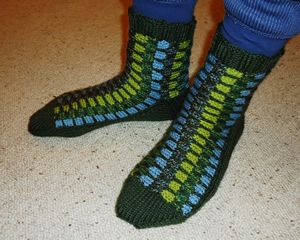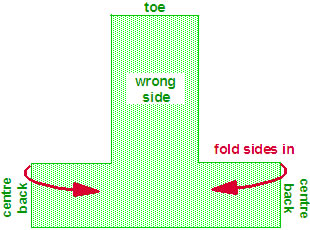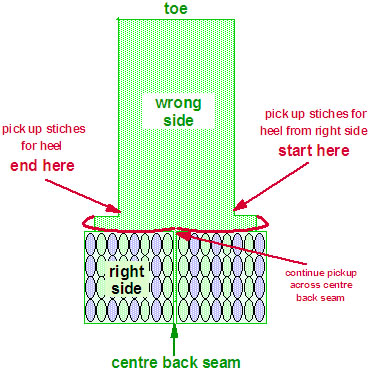Knitted Sideways Stash Socks
The Knitted Sideways Stash Socks are a wonderful choice for anyone who enjoys cozy and stylish footwear! With their unique design knitted sideways, these socks not only provide warmth but also stand out with a touch of creativity. Whether you're lounging at home or running errands, these socks will keep your feet happy and looking fabulous. Plus, the use of stash yarn adds a fun element of using up leftover yarn in a practical and eco-friendly way. Treat yourself to a pair of Knitted Sideways Stash Socks and step into comfort with a sprinkle of whimsy!

Materials
- 2 x 50g balls of double knitting yarn, and a variety of left over DK colours.
- One pair and one set of four No 8 (4mm) needles, pointed at both ends.
Tension
22 stitches = 4ins
Size matters
Length of foot, 9 inches (adjustable).
Abbreviations
- M is main shade (olive).
- C are contrasts.
- sl1: slip the next stitch
- k2tog or p2tog: work 2 sts together to decrease.
- psso: pass the slipped stitch over, (also known as "ssk"; effectively you are "knitting 2 together through back loops")
A Word on the Wool.
I used Phildar Oxygene in olive for the main colour, and a 4 other colours for the contrast - you could have every colour change (15 colours) different if you wanted.
Instructions.
The first section of these socks is knitted sideways making a "T" shape where the upright of the "T" is the upper foot, and the cross bar curls around the leg to form the cuff, meeting at the back seam.
The second section knits the heel and then sole of the sock. These two sections are worked on 2 needles.
Then for the toe, you pick up the stitches from the first 2 sections, and knit in the round on 4 needles, and finally you pick up stitches at the top of the sock and knit the welt, also in the round.
First section (knit 2)
Starting at the back leg seam, with main shade (M) cast on 23 sts on 2 needles and knit one row. Commence pattern.
Join in contrasts (C1, C2 etc):
1st row: Using C1, p3 * sl1, p3; repeat from * to end of row
2nd row: Using C1, k3 * sl1, k3; repeat from * to end of row
3rd row: As first row.
4th row: As second row.
5th row: Using main shade (M) purl across all sts.
6th row: Using C2, k1, sl1, * k3, sl1; repeat from * to last st, k1.
7th row: Using C2, p1, sl1, * p3, sl1; repeat from * to last st, p1.
8th row: As 6th row.
9th row: As 7th row.
10th row: Using main shade (M) knit across all sts.
Repeat rows 1-10 using different contrasts, once more.
Next row(wrong side facing): Cast on 40 sts, and then work across them and all sts, as for 1st row of pattern. [63sts]
Continue to work the pattern on these 63 sts, working rows 1-10 three times, and then rows 1-4.
Next row(wrong side facing): Using main shade, cast off 40 sts, and purl across remainder. [23sts]
Continue to work the pattern on these 23 sts, working rows 6-10, then rows 1-10 once, times, and then rows 1-4.
Cast off purlwise using main shade (centre back seam).
Second section (heel and sole).
The remainder of the socks are worked entirely in the main shade.
For the heel: with right side of the first section facing, oriented like an upside down "T" pick up 11 sts from each side of the instep:


Turn and purl 1 row across these 22 sts.
Next row(right side facing): * Sl1, k1, repeat from * to end.
Next row: Purl
Repeat the last 2 rows 10 times more.
Turn the heel:
Next row: Sl1, k12, k2tog, k1. Turn.
Next row: Sl1, p5, p2tog, p1. Turn.
Next row: Sl1, k6, k2tog, k1. Turn.
Next row: Sl1, p7, p2tog, p1. Turn.
Continue to work short rows and decrease in this way until all sts have been incorporated. [14sts].
Next row(right side facing): Sl1, k13, pick up and knit 13 sts down side of heel. Turn.
Next row: P27, pick up and purl 13 sts down other side of heel. Turn.
Now work the instep decreases and sole:
Next row: K1, sl1, k1, psso; knit to last 3 sts, k2tog k1. Turn.
Next row: Purl.
Repeat the last 2 rows until 22 sts remain.
[Editor's note: if you want to make the sock for a narrower foot circumference then decrease a few more sts here. About 6 sts for an inch.]
Continue to work a further 50 rows to make the sole - upper and lower foot sections should be about the same length.
[Editor's note: if you altered the sock length by casting on more of fewer than 40 sts, then adjust the number of rows you knit here. For every 4 sts different in the first section, allow 5 rows difference in the sole.]
Toe
Now we move to working in the round.
Knit 11 sts on first double-pointed needle, 11sts on second, then with right side facing, using third needle, pick up and knit 24 sts across the toe edge of the first section.
Complete the round, knitting 11 sts from first needle then 11 sts from second. Knit one more round.
Next round: K1, sl1, k1, psso; knit to last 3 sts on third needle, k2tog k1. Complete the round by knitting the 11 sts on each of the first and second needles. [44 sts]
Next round: K1, sl1, k1, psso; knit to last 3 sts on third needle, k2tog k1; on first needle, k1, sl1, k1 psso; knit to end; on second needle, knit to last 3 sts, k2tog k1.
Next round: Knit.
Repeat the last 2 rounds until 16sts remain.
Slip the sts from the second needle on to the first and graft the sts together with those on the third needle.
Making up
Sew seams on each side of the sole, using a flat seam technique (not mattress stitch for example).
Using double pointed needles and main shade, pick up 60-66 sts round top of sock and knit a k3/p3 rib for about 8 rows (or as long as you want), to form the welt. Cast off loosely.
Sew in all ends.